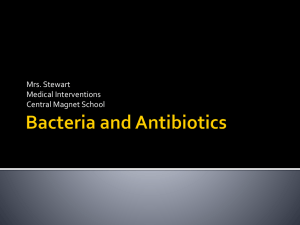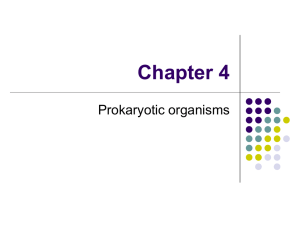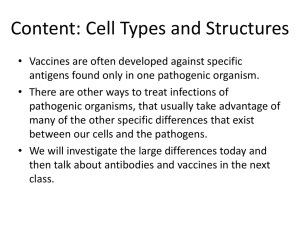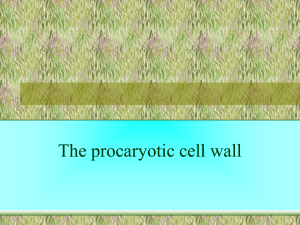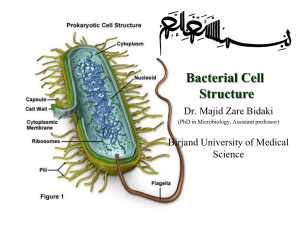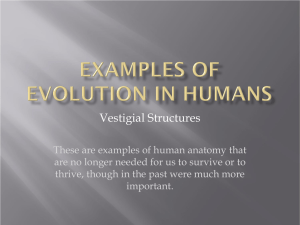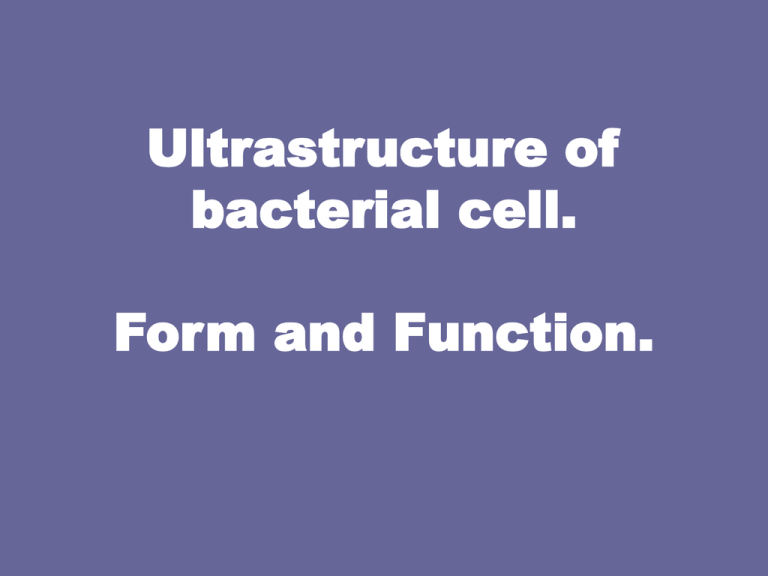
Ultrastructure of
bacterial cell.
Form and Function.
Structure of a Prokaryotic Cell
Bacterial Morphology and
Ultrastructure
• Only two types of cells are produced by all living
organisms on earth.
• Prokaryotes (pro. or primitive nucleus) do not have
a membrane bound nucleus
– eubacteria (true bacteria)
– archaebacteria (ancient bacteria)
• Eukaryotes (eu, or true nucleus) have a membrane
bound nucleus
–
–
–
–
–
Algae
fungi
protozoa
plants
animals
Prokaryotes
Chemical Composition of
Bacteria
•
•
Water - 70%
Dry weight - 30% composed of:
–
–
–
DNA - 5% MW 2,000,000,000
RNA - 12%
protein- 70% found in:
•
•
•
•
–
–
–
Ribosomes(10,000) – RNA
Protein particles - MW 3,000,000
Enzymes
Surface structures
polysaccharides - 5%
lipids - 6%
phospholipids - 4%
Prokaryote Structures:
1. Appendages- flagella, pili, fimbrae
2. Cell envelope- glycocalyx, cell wall , cell
membrane
3. Cytoplasm- ribosomes, granules,
nucleoid/chromosome.
Appendages
Bacterial Appendages:
•
Pili (pl), pilus (s)
– only found in gram negative bacteria
– tubulare, hairlike structures of protein larger
and more rare than fimbriae.
•
2 types of pili
-
atacnement pilus - allow bacteria to attach to
other cells
-
sex pilus, - transfer from one bacterial cell to
another- conjugation.
Fimbriae
• fimbriae (pl) fimbria (s)
– Adhesion to cells and surfaces
– Responsible for biofilms.
– Pathogenesis of gonococcus and E.coli
Escherichia coli.
Flagella
• Flagella (pl), flagellum(s)
– long appendages which rotate by means of a "motor"
located just under the cytoplasmic membrane.
– bacteria may have one, a few, or many flagella in
different positions on the cell.
• Advantages
- chemotaxis - positive and negative.
- motility
• All spirilla, half of bacilli, rare cocci.
Structure of flagella
allows for 360 degree filament rotation
Flagella
Three morphological regions
•
Helical filament
–
–
•
long outermost region; composes up to 90% of its length
contains the globular (roughly spherical) protein flagellin
arranged in several chains and form a helix around a hollow
core
Hooked or curved area
–
•
filament is attached; consists of a different protein
Basal body
–
–
–
terminal portion of the flagellum
fix the flagellum to the cell wall and plasma membrane
composed of a central rod inserted into a series of rings
Gram negative - 2 pairs of rings
•
•
Outer pair - fixed to the outer membrane and peptidoglycan
layer
Inner pair - fixed to the plasma membrane (SM ring)
Gram positive - only inner pair is present
Motility
•
Types of bacterial motility
–
–
–
•
run or swim - when a bacterium moves in one direction
for a length of time
tumbles - periodic, abrupt random changes in direction
swarming - rapid wavelike growth across a solid culture
medium
Mechanism of flagellar movement - relative
rotation of the rings in the basal body of the
flagellum
Antigenicity
–
flagellar or H antigen - useful in the serological
identification of serotypes of Salmonella organisms
Arrangements
• Flagella vary in number and arrangement.
• Polar arrangment
– Monotrichious - 1 flagellum at one end
• Fastest; Pseudomonas -example
– Lophotrichious - tuft at one end
– Amphitrichious- bipolar
– Peritrichious - multiple flagella; randomly
dispersed around the bacterial cell
• E. coli - example
Flagellar arrangements
A. Monotrichous
B. Lophotrichous
C. Amphitrichous
D. Peritrichous
E. Atrichous
Axial filaments
Axial filaments
•
tuft of fibrils that arise at the ends
of the cell under the outer
membrane and spiral around the
cell
•
rotation an opposing of the outer
membrane movement that propels
the spirochetes by causing them to
move like corkscrews
•
Found in Spirochetes and are
similar to flagella, but are located
between the cell wall and an
outer membrane, and are
attached to one end of the
organism.
Evidence of motility
Two ways by which motility can be demonstrated:
• direct or microscopic
– hanging drop preparation or wet mount preparation by dark field
mycroscope
– Distinguishes:
• Brownian movement - when the bacteria show molecular movement
• true motility - if a bacterium describes a rotatory, undulatory or
sinuous movement
• indirect or macroscopic
– Stab inoculation of the semisolid media
• nonmotile - growth is limited at the point of inoculation
• motile - growth is diffuse or moves away from the line of inoculation;
turbidity of the medium
Detection of Motility
• Direct
• Indirect
Presence mobile bacteria
• Bacterial motility (QuickTime movie)
• http://diverge.hunter.cuny.edu/~weigang/A
nimations/SalmonellaFlagella-S.mov
Prokaryote Structures:
1. Appendages- flagella, pili, fimbrae
2. Cell envelope
A. glycocalyx
B. cell wall
C. cell membrane
3. Cytoplasm- ribosomes, granules,
nucleoid/chromosome.
2. Bacterial Surface Structure
- cell envelope
A. Glycocalyx - some extracellular material
secreted by many bacterial cells in the form of:
a. capsule - attached tightly to the bacterium and has
definite boundaries.
b. slime layer - loosely associated with the bacterium
and can be easily washed off
Compositions:
-
layer of polysaccharide
proteins - sometimes
Functions of the Capsule
•
•
•
•
•
Protection
Identification
Vaccine preparation
Tissue attachment
Antibiotic barrier
Medical Importance rapid serological identification of:
• Several groups of streptococci
• Meningococcus
• Hemophilus influenzae
• Klebsiella pneumoniae
• Some of the coliforms
• Yersinia and Bacillus specie
•
Identification
Two simple methods to distinguish the capsule
India ink technique - most satisfactory method of demonstrating
the capsule by Burri-Gins technique
– Bacteria is suspended in diluted India ink
– Stain with fuxin
– Bacterial cells appear to lie in a lacunae
and red cytoplasme.
Quellung reaction - Homologous antibody is added to a
preparation of capsule.
– microprecipitation at the periphery of the capsule altering its
refractive index rendering the capsule to be visible
Staining by Burri-Gins
Neisseria meningitidis - Gramnegative coccus, non-motile bacteria occur
as two cells (orange) in a capsule (yellow)
Haemophilus influenza bacteria in the
process of expressing polysaccharide capsules.
Cell wall
Peptidoglycan (polysaccharides +
protein),
•
Support and shape of a bacterial cell.
The three primary shapes in
bacteria are:
• coccus (spherical),
• bacillus (rod-shaped)
• spirillum (spiral).
• Mycoplasma are bacteria
that have no cell wall and
therefore have no definite
shape.
Cell wall
peptidoglycan (polysaccharides + protein)
Components of the peptidoglycan layer:
– Repeating glycan chains (N acetyl
glucosamine and N acetyl muramic acid)
– a set of identical tetrapeptide side
chains attached to N- acetylmuramic
acid
– a set of identical peptide cross bridges
Peptidoglycan
Differences in Cell Wall
Structure
• Basis of Gram Stain Reaction
– Hans Christian Gram- 1884
• Differential Stain
– Gram Positive vs Gram Negative Cells
• Gram Positive Cells– Thick peptidoglycan layer with embedded teichoic
acids
• Gram Negative Cells– Thin peptidoglycan layer, outer membrane of
lipopolysaccharide.
Cell wall
Gram Stain Reaction
• Hans Christian Gram- 1880s
• Divides bacteria into 2 main groups– Gram positive
– Gram negative
• Also- gram variable
• Gram nonreactive
• Gram positive bacteria
– many layers of peptidoglycan and teichoic acids.
– form a crystal violet-iodine-teichoic acid complex
• Large complex, difficult to decolorize
Gram positive bacteria
Gram Stain Reaction
• Gram negative bacteria
–
–
–
–
Very thin peptidoglycan
No teichoic acids
Alcohol readily removes the crystal violet.
Alcohol also dissolves the lipopolysaccharide of the cell wall.
• Gram variable cells
– Some cells retain crystal violet; some decolorize and take up the
safranin
– 4 factors•
•
•
•
Genetics- variable amount of teichoic acid.
Age of culture- older cultures have variable amount of teichoic acid
Growth medium- necessary nutrients not available
Technique– smear not thin or evenly made.
– Staining procedure not done correctly- decolorizer left on too long.
Gram negative bacteria
Gram stain technique
Gram stain
Gram stain
• Gram nonreactive cells
– Have peptidoglycan but have very waxy- thick
lipids –waterproof, dyes cannot enter either.
– Examples- Mycobacterium tuberculosis and
leprosy.
• Alternative staining- acid fast stain
Cell wall deficient forms
• L- forms ( Lister Institute where discovered)
– Bacteria loses cell wall during the life cycle
• Result of a mutation in cell wall forming genes
• Induced by treating with lysozyme or penicillin which disrupts
the cell wall
– Protoplast• G + bacterium with no c. wall, only a c. membrane
• Fragile, easily lysed
– Spheroplast• G – bacterium loses peptidoglycan, but has outer membrane
• Less fragile but weakened.
Surface structures
continued:
• Outer membrane
– This lipid bilayer is found in Gram negative
bacteria and is the source of
lipopolysaccharide (LPS) in these bacteria
– LPS is toxic and turns on the immune
system.
– Not found in Gram positive bacteria.
Lipopolysaccharide
C. Cell membrane
• Located just under cell wall
• Very thin
• Lipid bilayer, similar to the plasma membrane of
other cells. Transport of ions, nutrients and
waste across the membrane
• Typical
– 30-40% phospholipids
– 60-70% proteins
• Exceptions– Mycoplasma- sterols
– Archaea- unique branched hydrocarbons
Mesosome
Extension of cell membrane
– Folding into cytoplasm – internal pouch
– Increases surface area.
• Gram-positive bacteria-prominent
• Gram negative bacteria- smaller, harder to see.
• Functions– Cell wall synthesis
– Guides duplicated
chromosomes into
the daughter cells
in cell division.
Functions of Cell Membrane
• Carries out functions normally carried out by eukaryote
organelles.
• Site for energy functions
• Nutrient processing
• Synthesis
• Transport of nutrients and waste
• Selectively permeable
• Most enzymes of respiration and ATP synthesis
• Enzyme synthesis of structural macromolecules
– Cell envelope and appendages
• Secretion of toxins and enzymes into environment.
Prokaryote Structures:
1. Appendages- flagella, pili, fimbrae
2. Cell envelope
A. glycocalyx
B. cell wall
C. cell membrane
3. Cytoplasm
A.
B.
C.
D.
Nucleoid/chromosome
Plasmid
Ribosomes
Granules
3. Cell cytoplasm
• Encased by cell membrane
• Dense, gelatinous
• Prominent site for biochemical and
synthetic activities
• 70-80% water- solvent
• Mixture of nutrients- sugar, amino acids,
salts
– Building blacks for cell synthesis and energy
A. Bacterial chromosome
• Singular circular strand of DNA
• Aggregated in a dense area- nucleiod
• Long molecule of DNA tightly coiled
around protein molecules.
B. Plasmids
– Nonessential pieces of DNA
• Often confer protection- resistance to drugs
– Tiny, circular
– Free or integrated
– Duplicate and are passed on to offspring
– Used in genetic engineering
Types of plasmid
• Fertility-F-plasmids. They are capable of conjugation (transfer of
genetic material between bacteria which are touching).
• Resistance-(R)plasmids, which contain genes that can build a
resistance against antibiotics or poisons and help bacteria produce
pili.
• Col-plasmids, which contain genes that determine the production
of bacteriocins, proteins that can kill other bacteria.
• Degradative plasmids, which enable the digestion of unusual
substances, e.g., toluene or salicylic acid.
• Virulence plasmids, which turn the bacterium into a pathogen
(one that causes disease).
Cell division in Prokaryotes
• Prokaryotes use a
relatively simple form of
cell division - binary
fission.
• The diagram at 1.shows a
bacterial cell.
• The cell wall and membrane
are in red,
• the bacterial chromosome in
blue,
• the cytoplasm in light green,
• the yellow dot represents a
point of attachment of the
chromosome to the cell
membrane.
C. Ribosomes
• Site of protein synthesis
• Thousands
– Occurs in chains –polysomes
• 70S
– 2 smaller subunits
– 30S and 50S
D. Inclusions
• If nutrients abundant- stored intracellularly
• Granules
– Crystals of inorganic compounds not enclosed
by membranes
• Polyphosphate- corynebacterium
• Sulfur granules- photosynthetic
• Metachromatic- Mycobacterium
Bacterial Internal
Structures
• Endospores
– inert, resting, cells produced by some G+ genera:
Clostridium, Bacillus and Sporosarcina
• have a 2-phase life cycle:
– vegetative cell – metabolically active and growing
– endospore – when exposed to adverse environmental conditions;
capable of high resistance and very long-term survival
» Features of spores- size, shape, location=identification
– sporulation -formation of endospores
•
•
•
•
hardiest of all life forms
Forms inside a cell- functions in survival
not a means of reproduction
withstands extremes in heat, drying, freezing, radiation and
chemicals
– germination- return to vegetative growth
Endospores
• Resistance linked to high levels of calcium
and dipicolinic acid
• Dehydrated, metabolically inactive thick coat
• Longevity verges on immortality - 25,250
million years.
• Resistant to ordinary cleaning methods and
boiling
• Pressurized steam at 120oC for 20-30
minutes will destroy
Bacterial Shapes,
Arrangements, and Sizes
• Variety in shape, size, and arrangement
but typically described by one of three
basic shapes:
– coccus - spherical
– bacillus – rod
• coccobacillus – very short and plump
• vibrio – gently curved
– spirillum - helical, comma, twisted rod,
• spirochete – spring-like
Thank you!




